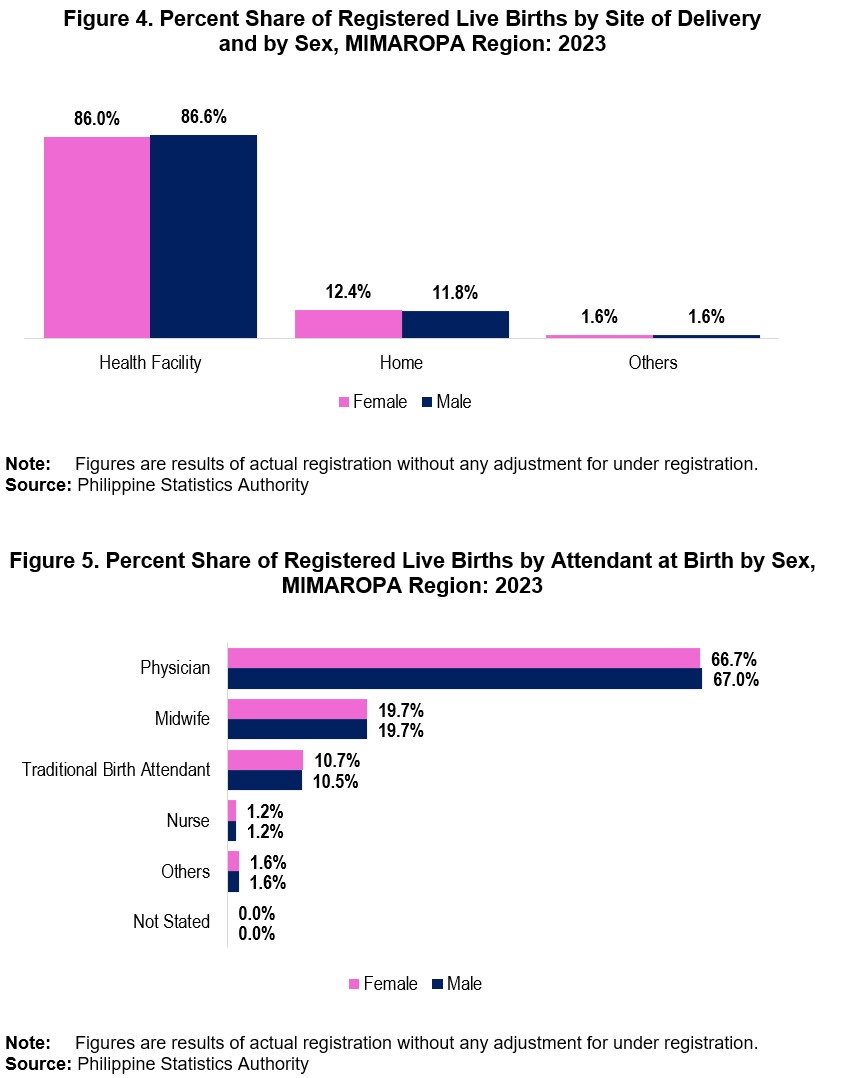Explanatory Notes Data on births presented in this release were obtained from the timely and late registered births at the Office of the City/Municipal Civil Registrars all throughout the country and submitted to the Office of the Civil Registrar General through the Philippine Statistics Authority (PSA) - Provincial Statistical Offices (PSOs). The information presented includes births that occurred from January to December 2023 based on data files received by the PSA - Civil Registration Service (CRS) from the PSOs. Figures presented herein are not adjusted for under registration. This release includes births of Filipinos whose usual residence is abroad and births of foreign nationals that occurred in the country during the reference period. Births of Filipinos abroad which were reported to the Philippine Foreign Service Posts are presented in a separate report. This release also includes comprehensive sex-disaggregated data for birth statistics, providing a detailed breakdown by sex for the MIMAROPA Region as a whole, as well as its individual provinces and the highly urbanized city within its jurisdiction. |
Marinduque has the highest proportion of male to female ratio
In 2023, a total of 20,728 females (47.9%) and 22,559 males (52.1%) were born in the region. This results in an overall sex ratio of 109 males per 100 females. (Figure 1)
Among its provinces and highly urbanized city, Marinduque stood out with the highest sex ratio at 117, followed closely by Oriental Mindoro and Palawan (excluding PPC), each with a sex ratio of 110. Meanwhile, the City of Puerto Princesa had the lowest sex ratio in the region at 103 males per 100 females. (Figure 2)

Most number of female births are registered in January
In 2023, most registered female births occurred in January with 1,947 births, accounting for 9.4 percent of the total regionwide female population. It was followed by the months of September with 1,945 births (9.4%) and October with 1,898 births (9.2%). On the other hand, the month of February had the least number of female live births contributing only 1,550 births or 7.5 percent. (Figure 3)
For male births in the same year, September led with the highest number at 2,117, making up 9.4 percent of the regionwide total male population. This was followed closely by October with 2,085 births (9.2%) and January with 2,063 births (9.1%). In contrast, June recorded the fewest male live births, contributing just 7.5 percent. (Figure 3)

At least 17 out of 20 female and male births took place in a health facility
In 2023, a total of 17,816 female live births (86.0%) occurred in health facilities, while 2,570 (12.4%) took place at home. All provinces except Palawan, but including the City of Puerto Princesa, reported over 85 percent of female births in health facilities. Marinduque had the highest rate at 97.5 percent, followed by the City of Puerto Princesa (97.2%) and Romblon (96.3%). In contrast, Palawan recorded the lowest proportion of female births in health facilities at 72.7 percent and the highest share of home deliveries at 23.9 percent. (Figure 4)
Similarly, for male live births, 19,545 (86.6%) occurred in health facilities, while 2,654 (11.8%) were home births. Marinduque led with the highest rate of health facility deliveries for male births at 97.7 percent, followed by the City of Puerto Princesa (97.6%) and Romblon (95.4%). (Figure 4)

About eight out of nine female and male birth deliveries were medically attended
Of the 20,728 female live births in the region, 18,162 deliveries (87.6%) were attended by health professionals, such as physicians, midwives, or nurses. Physicians handled the majority of this, accounting for 66.7 percent, followed by midwives at 19.7 percent and nurses at 1.2 percent. In contrast, 10.7 percent of female births were attended by hilots or traditional birth attendants. (Figure 5)
Similarly, about nine in ten male birth deliveries (88.2%) were medically attended, with physicians assisting 67.0 percent, midwives at 19.7 percent, and nurses 1.2 at percent. Meanwhile, 10.2 percent were delivered by traditional birth attendants. (Figure 5)
One in three female and male babies were firstborns
In 2023, the MIMAROPA Region recorded 43,287 live births, with firstborns being the most common birth order at 14,630 (33.8%), followed by second-borns at 11,817 (27.3%) and third-borns at 7,922 (18.3%). Of the 14,630 firstborns, 6,969 (47.6%) were female and 7,661 (52.4%) were male. (Figure 6)

Eight in ten newborn female and male babies weighed at least 2,500 grams
Birth weight serves as a measure of the nutritional status of newborns. Low birth weight is defined by the World Health Organization (WHO) as weight at birth less than 2,500 grams (5.5 lbs.). In 2023, of the total number of newborn babies, 84.2 percent of female babies and 85.6 percent of male babies weighted above the low birth weight threshold. Moreover, the median birth weight for female and male babies were 2,880 grams and 2,936 grams, respectively. (Figure 7)
In 2023, female babies in the MIMAROPA Region were slightly more likely to weigh between 2,500 and 2,999 grams, with 45.2 percent falling into this range compared to 41.0 percent of male babies. More than one in three babies weighed between 3,000 and 3,499 grams, with 32.0 percent being female and 35.5 percent male. Meanwhile, 0.1 percent of both female and male babies were born weighing less than 1,000 grams. (Figure 7)

(SGD) LENI R. RIOFLORIDO
Regional Director
MLLM / RRL / LACB

